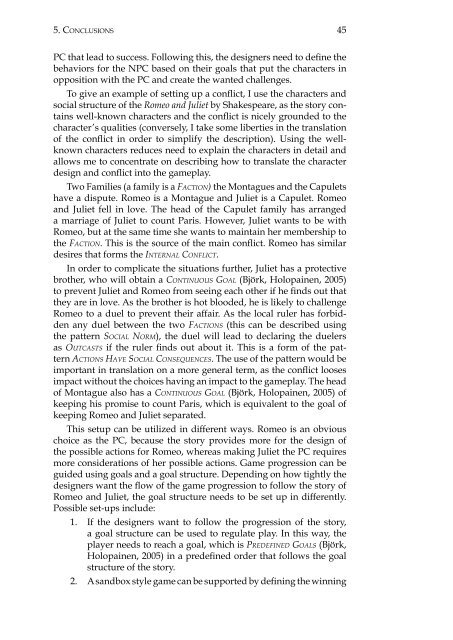Character Driven Game Design
Character Driven Game Design
Character Driven Game Design
You also want an ePaper? Increase the reach of your titles
YUMPU automatically turns print PDFs into web optimized ePapers that Google loves.
5. Conclusions 45<br />
PC that lead to success. Following this, the designers need to define the<br />
behaviors for the NPC based on their goals that put the characters in<br />
opposition with the PC and create the wanted challenges.<br />
To give an example of setting up a conflict, I use the characters and<br />
social structure of the Romeo and Juliet by Shakespeare, as the story contains<br />
well-known characters and the conflict is nicely grounded to the<br />
character’s qualities (conversely, I take some liberties in the translation<br />
of the conflict in order to simplify the description). Using the wellknown<br />
characters reduces need to explain the characters in detail and<br />
allows me to concentrate on describing how to translate the character<br />
design and conflict into the gameplay.<br />
Two Families (a family is a Faction) the Montagues and the Capulets<br />
have a dispute. Romeo is a Montague and Juliet is a Capulet. Romeo<br />
and Juliet fell in love. The head of the Capulet family has arranged<br />
a marriage of Juliet to count Paris. However, Juliet wants to be with<br />
Romeo, but at the same time she wants to maintain her membership to<br />
the Faction. This is the source of the main conflict. Romeo has similar<br />
desires that forms the Internal Conflict.<br />
In order to complicate the situations further, Juliet has a protective<br />
brother, who will obtain a Continuous Goal (Björk, Holopainen, 2005)<br />
to prevent Juliet and Romeo from seeing each other if he finds out that<br />
they are in love. As the brother is hot blooded, he is likely to challenge<br />
Romeo to a duel to prevent their affair. As the local ruler has forbidden<br />
any duel between the two Factions (this can be described using<br />
the pattern Social Norm), the duel will lead to declaring the duelers<br />
as Outcasts if the ruler finds out about it. This is a form of the pattern<br />
Actions Have Social Consequences. The use of the pattern would be<br />
important in translation on a more general term, as the conflict looses<br />
impact without the choices having an impact to the gameplay. The head<br />
of Montague also has a Continuous Goal (Björk, Holopainen, 2005) of<br />
keeping his promise to count Paris, which is equivalent to the goal of<br />
keeping Romeo and Juliet separated.<br />
This setup can be utilized in different ways. Romeo is an obvious<br />
choice as the PC, because the story provides more for the design of<br />
the possible actions for Romeo, whereas making Juliet the PC requires<br />
more considerations of her possible actions. <strong>Game</strong> progression can be<br />
guided using goals and a goal structure. Depending on how tightly the<br />
designers want the flow of the game progression to follow the story of<br />
Romeo and Juliet, the goal structure needs to be set up in differently.<br />
Possible set-ups include:<br />
1. If the designers want to follow the progression of the story,<br />
a goal structure can be used to regulate play. In this way, the<br />
player needs to reach a goal, which is Predefined Goals (Björk,<br />
Holopainen, 2005) in a predefined order that follows the goal<br />
structure of the story.<br />
2. A sandbox style game can be supported by defining the winning
















